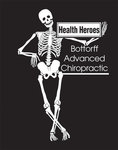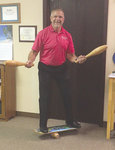

This week’s Health Hero is so important everyone should make an effort every day to get closer to her. This hero will improve your quality of life and your ability to perform simple activities of daily living. Our hero is balance.
The field of physical balance is vast and impossible to do justice in one column. There are some guidelines for the average person that can be helpful and worth the conversation. Balance can be considered to be the ability to control the placement of the body’s center of gravity in relation to its support base. For our discussion and simplicity I will include the following as part of balance. Agility is the ability to minimize transition time from one movement to another. Coordination or the ability to combine several distinct movement patterns into a singular distinct movement. Finally there is accuracy or the ability to control movement in a given intensity so you’re not crushing your glass when you take a sip of water. Simple right? If anything realize all this is taking place with every movement you perform.
Your nervous system is “plastic” and grows with demand, or shrinks because of the lack of demand. So your nervous system grows like a muscle that is being used. Practice is what causes it to grow. We practice learning how to ride a bike or read a book. New file folders are constantly being developed as a response to brain and nervous system growth.
Watching the nervous system grow is more obvious in watching newborns do more and more as the systems boot up. Playing causes nerve growth and organization by movement that becomes more and more complex like hopscotch and jumping rope. I mentioned before that there are nerve receptors in the joint and surrounding tissues, which include muscles ligaments and tendons. They send an endless stream of information called stimuli to your brain through nerve pathways. These stimuli “stimulate” the brain giving it information to determine where you are in space. This process is called proprioception, a big factor in balance.
To help me with this subject I called on a physiotherapist Andrea Russell Schroeter. She graduated from North Montgomery in 1997 and was a sectional swimming champion all four years in the 100 fly and 100 back stroke. She swam four years at Ball State and ended up as team captain and MVP in her senior year. She was graduate cum laude with honors and a bachelor’s degree in exercise science. She earned her physiotherapy degree from the University of Indianapolis and is currently working to rehabilitate persons who have been hospitalized with the intent of returning them home. She is employed by Wellbrooke of Crawfordsville.
To evaluate balance Schroeter looks to three areas: somatosensory, or the messages sent to the brain from the joints and surrounding tissue; the vestibular system, which is the switchboard for balance in your brain, and the third area is vision.
“The importance of range of motion and flexibility in the entire body specifically the lower limbs and trunk is key,” she said.
So you have to be able to move in a way to get to a point of balance and doing so requires muscle strength. Muscle endurance then helps with balancing when you are in movement.
As complicated as all this sounds, it boils down to the fact that with persistent practice, you can maintain and improve balance and safe movement at any stage in life. For the freedom of movement that a baby craves when it learns to crawl or a great-grandparent dancing at a wedding.
Next week we will talk about age, injury and recovery.
See you in the pool.